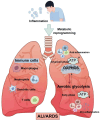The impact of glucose metabolism on inflammatory processes in sepsis-induced acute lung injury
- PMID: 39712019
- PMCID: PMC11659153
- DOI: 10.3389/fimmu.2024.1508985
The impact of glucose metabolism on inflammatory processes in sepsis-induced acute lung injury
Abstract
Acute lung injury (ALI) is a prevalent and critical complication of sepsis, marked by high incidence and mortality rates, with its pathogenesis still not being fully elucidated. Recent research has revealed a significant correlation between the metabolic reprogramming of glucose and sepsis-associated ALI (S-ALI). Throughout the course of S-ALI, immune cells, including macrophages and dendritic cells, undergo metabolic shifts to accommodate the intricate demands of immune function that emerge as sepsis advances. Indeed, glucose metabolic reprogramming in S-ALI serves as a double-edged sword, fueling inflammatory immune responses in the initial stages and subsequently initiating anti-inflammatory responses as the disease evolves. In this review, we delineate the current research progress concerning the pathogenic mechanisms linked to glucose metabolic reprogramming in S-ALI, with a focus on the pertinent immune cells implicated. We encapsulate the impact of glucose metabolic reprogramming on the onset, progression, and prognosis of S-ALI. Ultimately, by examining key regulatory factors within metabolic intermediates and enzymes, We have identified potential therapeutic targets linked to metabolic reprogramming, striving to tackle the inherent challenges in diagnosing and treating Severe Acute Lung Injury (S-ALI) with greater efficacy.
Keywords: ALI; glycolysis; immune response; metabolic reprogramming; oxidative phosphorylation (OXPHOS); sepsis.
Copyright © 2024 Cheng, Li, Sun, Liu, Guo, Wu, Yang, Wei, Wu, Xu, Yang and Wu.
Conflict of interest statement
The authors declare that the research was conducted in the absence of any commercial or financial relationships that could be construed as a potential conflict of interest.
Figures




Similar articles
-
Aquaporins in sepsis- an update.Front Immunol. 2024 Oct 31;15:1495206. doi: 10.3389/fimmu.2024.1495206. eCollection 2024. Front Immunol. 2024. PMID: 39544938 Free PMC article. Review.
-
Macrophages in sepsis-induced acute lung injury: exosomal modulation and therapeutic potential.Front Immunol. 2025 Jan 7;15:1518008. doi: 10.3389/fimmu.2024.1518008. eCollection 2024. Front Immunol. 2025. PMID: 39840035 Free PMC article. Review.
-
Targeting immunometabolism against acute lung injury.Clin Immunol. 2023 Apr;249:109289. doi: 10.1016/j.clim.2023.109289. Epub 2023 Mar 12. Clin Immunol. 2023. PMID: 36918041 Free PMC article. Review.
-
Immunometabolic reprogramming of macrophages with inhalable CRISPR/Cas9 nanotherapeutics for acute lung injury intervention.Acta Biomater. 2024 Jun;181:308-316. doi: 10.1016/j.actbio.2024.03.031. Epub 2024 Apr 1. Acta Biomater. 2024. PMID: 38570107
-
Pulmonary Innate Immune Response Determines the Outcome of Inflammation During Pneumonia and Sepsis-Associated Acute Lung Injury.Front Immunol. 2020 Aug 4;11:1722. doi: 10.3389/fimmu.2020.01722. eCollection 2020. Front Immunol. 2020. PMID: 32849610 Free PMC article. Review.
Cited by
-
Impact of hemoglobin glycation index on prognosis in critical patients with acute ischemic stroke: A retrospective cohort study using MIMIC-IV 2.2 database.Sci Rep. 2025 Jul 2;15(1):23095. doi: 10.1038/s41598-025-07833-6. Sci Rep. 2025. PMID: 40595190 Free PMC article.
-
Combined Analysis of Transcriptome and Mendelian Randomization Reveals AKT1 and PPARG as Biomarkers Related to Glucose Metabolism in Sepsis.J Inflamm Res. 2025 Jul 30;18:10213-10234. doi: 10.2147/JIR.S528347. eCollection 2025. J Inflamm Res. 2025. PMID: 40756416 Free PMC article.
-
From Glucotoxicity to Lung Injury: Emerging Perspectives on Diabetes-Associated Respiratory Complications.Lung. 2025 Jul 15;203(1):80. doi: 10.1007/s00408-025-00834-2. Lung. 2025. PMID: 40665066 Review.
References
-
- Thomas-Rüddel DO, Fröhlich H, Schwarzkopf D, Bloos F, Riessen R. Sepsis and underlying comorbidities in intensive care unit patients: Analysis of the cause of death by different clinicians-a pilot study. Medizinische Klinik Intensivmedizin und Notfallmedizin. (2024) 119:123–8. doi: 10.1007/s00063-023-01037-4 - DOI - PMC - PubMed
Publication types
MeSH terms
Substances
LinkOut - more resources
Full Text Sources
Medical

